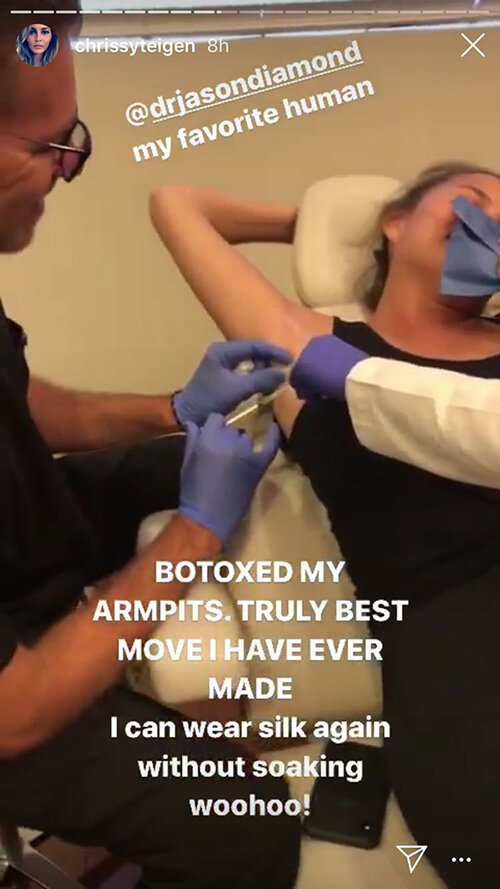From headaches to excess sweating, Botox can offer relief from a range of medical conditions.
_____
Botox is a protein made from Botulinum toxin that weakens or relaxes muscle. When used correctly and in small doses, it has both medical and cosmetic benefits. DR MICHAEL O’GORMAN explains the medical conditions that Botox injections can help treat.
01
Excessive Sweating (Hyperhidrosis)
Many of us suffer from excessive sweating, a condition that can lead to embarrassing moments – from wet armpits – to a clammy handshake. While clinical strength deodorant can help reduce symptoms, more women and men are turning to therapeutic tox injections (Botox) to significantly reduce sweating to different parts of the body.
The release of sweat from the sweat glands onto the surface of the skin is controlled by small muscles. Botox acts on the nerve and prevents the contraction that causes sweating.
While sweating is necessary for our bodies to maintain healthy temperature levels, when used in targeted areas of the body, repeated Botox treatments have been shown to be safe.
And the results? Expect the treatment to minimise sweating by at least 80%, with a majority of patients reporting complete freedom from antiperspirants. Chrissy Teigen is a fan and believes it’s the “best move” she’s ever made, as it has enabled her to wear silk again.
Each round of Botox lasts roughly six months before you need a top-up. And the good news is that this quick and safe treatment does not increase sweating in other parts of the body.

Image: @chrissyteigen / Instagram
_____
Tension & Migraine Headaches
Botox can be a game-changer for people that suffer from tension or migraine headaches.
In 1998, an American plastic surgeon reported some of his patients receiving cosmetic Botox experienced an improvement in their migraine headaches after treatment.
Encouraged by other anecdotal evidence, researchers began to formally study the efficacy, safety and tolerability of Botox for chronic migraine through clinical trials. The results from the clinical trials concluded that treating chronic migraine with Botox reduced the number of migraine days and reduced headache-related disability*. This is because Botox paralyzes the nerve terminals which stops the process of pain patterning and also relaxes the muscles.
For some people it even eliminates the need for ongoing medication, but with any medical procedure, everybody responds to treatment slightly differently.
_____
Eyelid Spasms (Blepharospasm)
Unable to open your eye, blinking with no end, spasms you just can’t control – if you experience these intrusive symptoms, you may have blepharospasm. Blepharospasm can cause severe visual disturbance and while its cause is not known, it affects older people and can run in families. This condition can be a challenge to live with.
Botox was first used in the 1970s by ophthalmologists to treat eye conditions such as blepharospasm and squinting. Blocking signals from the nerves that tell the muscles that control the affected areas to contract, it was found to reduce eye muscle spasms.
After treatment, symptoms usually improve within the first three days, with maximum results about one to two weeks after treatment. The effects last around three months so patients must return regularly for further injections.
_____
Bruxism & TMD (Jaw tension)
Otherwise known as Bruxism, regular teeth grinding and jaw clenching is not only painful but can have other nasty side effects. Botox can not only help ease symptoms, it can sometimes give a surprising facial-slimming effect.
Bruxism normally manifests as a physical side effect of stress and can lead to Temperomandibular Joint Dysfunction (TMJ or TMD). Associated symptoms such as jaw pain, headaches or teeth damage caused by grinding, usually at night, can lead to insomnia, restless sleep, or pain that disrupts sleep.
By injecting small amounts of Botox into the masseter muscle of the jaw (responsible for grinding, clenching and chewing), we can reduce the over-active muscle action, but still maintain normal function. The neurotoxin blocks the nerve impulses to the muscles, which inhibits the muscle contraction.
Once the tension has been released, the injections can also work to slim the face, reducing an over-exaggerated wide lower face or square jaw.
It is worth trialling a light dose to see if it has a positive effect on reducing teeth grinding and TMJ dysfunction if you’ve tried other options without success.
_____
*Source: Blumenfeld, A. (2019). Botox: Separating Fact from Fiction. Migraine World Summit transcript, Blumenfeld, A. (2019). Botox for Migraine. MigrainePal.
